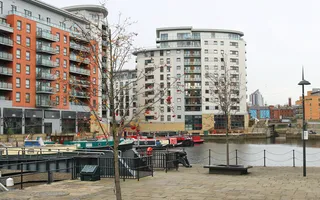Enjoy this 4km wellbeing walk along the canal from Leeds Dock to Thwaite Watermill.
Ever since 1625, Yorkshire entrepreneurs tried to improve navigation on the rivers Aire and Calder, cutting short canals to bypass narrow or tortuous stretches. The Aire & Calder Navigation connects in Leeds to the Leeds & Liverpool Canal, providing a vital link from the Humber ports and the North Sea across the Pennines to Liverpool. Today it carries over two million tons of freight each year, and is a popular route for leisure boats too. Your walk gives a glimpse into the heritage and engineering of this waterway.
Canal: Aire & Calder Navigation
Start: Leeds Dock OS Grid ref: SE308330 Postcode: LS10 1JE
Finish: Thwaite Watermill OS Grid ref: SE327311 Postcode: LS10 1RP
Distance: 4km / 2½ miles
Route instructions
Start: Your walk starts on Clarence Dock Bridge over the entrance to Leeds Dock. Looking west, the city centre peeps over the eye-catching red-steel Crown Point Bridge. Fearns Island creates a break in the River Aire, with the ferocious Leeds Dam Weir to the north of it, while boaters safely cruise south of the island east along the Aire & Calder Navigation towards Leeds Lock. Come down the steps to follow the path around the Grade II-listed historic Leeds Dock. The Dock would have been frenetically busy, with barges loading and offloading into stores and warehouses here and was once known as Potato Dock because of its main cargo! Seats along your route invite you to simply relax and watch boats.
1. A pedestrian Lift Bridge bisects the dock, so you could choose to shorten your loop around the dock here. Bright yellow water taxis run from the dock every 15 minutes to Granary Wharf and the Leeds & Liverpool Canal.
2. The Royal Armouries Museum on the riverside is one of the oldest museums in the world. It houses the national collections of arms and armour, artillery and firearms, a collection begun by King Charles 1 in 1631. The collection was originally housed in the Tower of London, and the bulk of the collection is now here in Leeds, with the rest in the Tower and at Fort Nelson near Portsmouth.
3. Keep your eyes peeled for birds and waterfowl attracted by the river weir. Turn right to follow the towpath past the dramatic white Knight's Way Footbridge towards the impressively large Leeds Lock. The huge lock channels boats towards the south bank of the river, avoiding the weir, and is overlooked by former Victorian warehouses on one side and the Museum on the other.
4. Almost immediately your surroundings become leafier as you round the bend away from the city. Street art is dotted along the riverside, and a new rust-coloured steel footbridge, opened in 2019, links the CITU development to the city's heart.
5. Heading away from Leeds, the A61 over the water is the last noisy intrusion on your walk. The imposing red-brick Grade II*-listed Victorian mill complex of Hunslet Mill and Victoria Works dwarfs the towpath. The last and largest of the great flax-spinning mills built in Leeds in the early 1800s, at one time it employed over 1500 female flax reelers. It was under threat of dereliction but is now being sympathetically developed into apartments.
6. The river widens as you follow the edge of the Knostrop Quay development and round a small basin. Cross the footbridge to the centre island and then a second footbridge to follow the tree-lined riverside path on the northern bank. From here, your surroundings become more lush and green.
7. The river splits again at Knostrop Lock, where you cross the footbridge over the stepped weir towards the lock. Follow the towpath past the tiny lock-keeper's hut and onward between the River Aire to your left and the Aire & Calder Navigation to your right. Passing a small carved stone circle, built in 1997 by a caretaker of the mill, the path joins a small lane leading to Thwaite Watermill.
End: Your walk ends at the dynamic island setting of Thwaite Watermill between the two waters, one of the last remaining examples of a water-powered mill in Britain. The former mill is now a museum about the Leeds milling industry. Relax by the water, explore the Watermill or hop on a bus back to Leeds Dock. Alternatively, follow the lane round to pick the towpath back up at Knostrop Lock, where you can cross over the lock to enjoy retracing this walk from a fresh angle.








